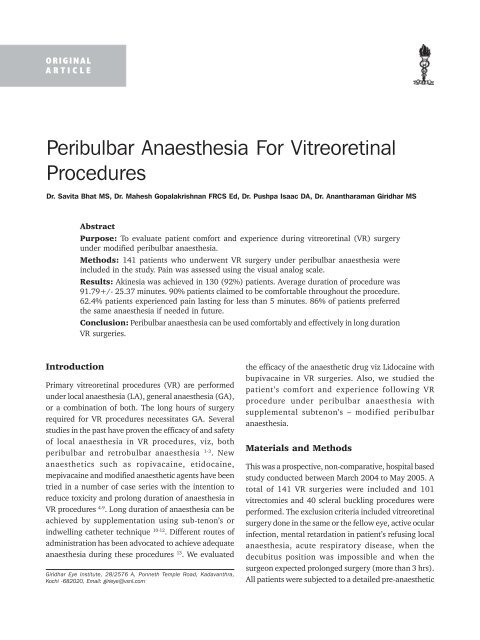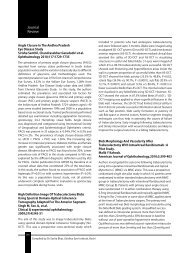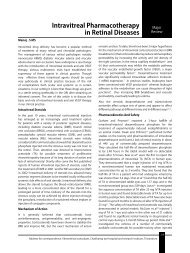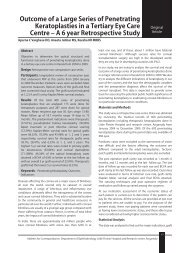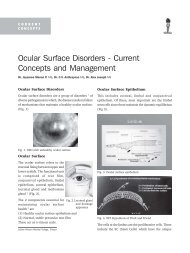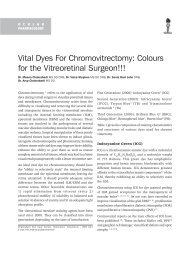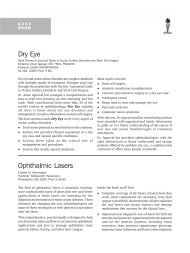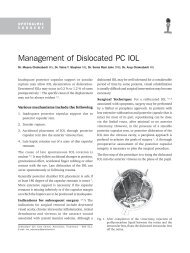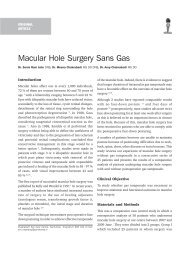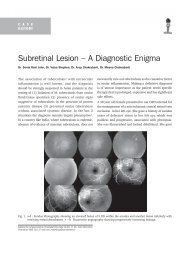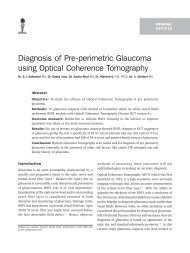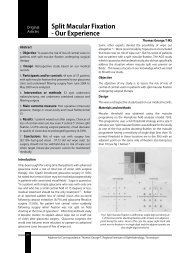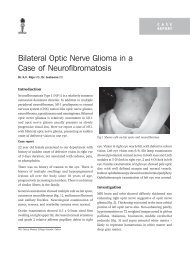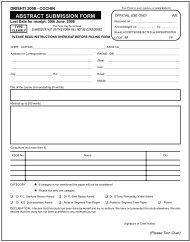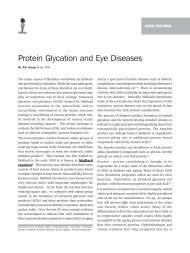Peribulbar Anaesthesia For Vitreoretinal Procedures - KSOS
Peribulbar Anaesthesia For Vitreoretinal Procedures - KSOS
Peribulbar Anaesthesia For Vitreoretinal Procedures - KSOS
Create successful ePaper yourself
Turn your PDF publications into a flip-book with our unique Google optimized e-Paper software.
270 Kerala Journal of Ophthalmology Vol. XIX, No. 3<br />
ORIGINAL<br />
ARTICLE<br />
<strong>Peribulbar</strong> <strong>Anaesthesia</strong> <strong>For</strong> <strong>Vitreoretinal</strong><br />
<strong>Procedures</strong><br />
Dr. Savita Bhat MS, Dr. Mahesh Gopalakrishnan FRCS Ed, Dr. Pushpa Isaac DA, Dr. Anantharaman Giridhar MS<br />
Introduction<br />
Abstract<br />
Purpose: To evaluate patient comfort and experience during vitreoretinal (VR) surgery<br />
under modified peribulbar anaesthesia.<br />
Methods: 141 patients who underwent VR surgery under peribulbar anaesthesia were<br />
included in the study. Pain was assessed using the visual analog scale.<br />
Results: Akinesia was achieved in 130 (92%) patients. Average duration of procedure was<br />
91.79+/- 25.37 minutes. 90% patients claimed to be comfortable throughout the procedure.<br />
62.4% patients experienced pain lasting for less than 5 minutes. 86% of patients preferred<br />
the same anaesthesia if needed in future.<br />
Conclusion: <strong>Peribulbar</strong> anaesthesia can be used comfortably and effectively in long duration<br />
VR surgeries.<br />
Primary vitreoretinal procedures (VR) are performed<br />
under local anaesthesia (LA), general anaesthesia (GA),<br />
or a combination of both. The long hours of surgery<br />
required for VR procedures necessitates GA. Several<br />
studies in the past have proven the efficacy of and safety<br />
of local anaesthesia in VR procedures, viz, both<br />
peribulbar and retrobulbar anaesthesia 1-3 . New<br />
anaesthetics such as ropivacaine, etidocaine,<br />
mepivacaine and modified anaesthetic agents have been<br />
tried in a number of case series with the intention to<br />
reduce toxicity and prolong duration of anaesthesia in<br />
VR procedures 4-9 . Long duration of anaesthesia can be<br />
achieved by supplementation using sub-tenon’s or<br />
indwelling catheter technique 10-12 . Different routes of<br />
administration has been advocated to achieve adequate<br />
anaesthesia during these procedures 13 . We evaluated<br />
Giridhar Eye Institute, 28/2576 A, Ponneth Temple Road, Kadavanthra,<br />
Kochi -682020, Email: girieye@vsnl.com<br />
the efficacy of the anaesthetic drug viz Lidocaine with<br />
bupivacaine in VR surgeries. Also, we studied the<br />
patient’s comfort and experience following VR<br />
procedure under peribulbar anaesthesia with<br />
supplemental subtenon’s – modified peribulbar<br />
anaesthesia.<br />
Materials and Methods<br />
This was a prospective, non-comparative, hospital based<br />
study conducted between March 2004 to May 2005. A<br />
total of 141 VR surgeries were included and 101<br />
vitrectomies and 40 scleral buckling procedures were<br />
performed. The exclusion criteria included vitreoretinal<br />
surgery done in the same or the fellow eye, active ocular<br />
infection, mental retardation in patient’s refusing local<br />
anaesthesia, acute respiratory disease, when the<br />
decubitus position was impossible and when the<br />
surgeon expected prolonged surgery (more than 3 hrs).<br />
All patients were subjected to a detailed pre-anaesthetic
September 2007 Savita Bhat et al. - Peribular anaesthesia for VR procedures 271<br />
work up including laboratory investigations. The<br />
weight, blood sugar, blood pressure and<br />
electrocardiogram were evaluated for all patients. All<br />
patients received pre operative medications, viz<br />
Ketorolac trometamol 10mg oral, Alprazolam 0.25 mg<br />
oral, Cefuroxime 750 mg intravenous one hour before<br />
surgery. All surgeries were performed in the presence<br />
of an anaesthesiologist. A short-acting drug for<br />
anxiolysis Midazolam 0.5 or 1 mg was administered<br />
5 minutes before peribulbar anesthesia in 18 patients<br />
who seemed very anxious. Assessment of anxiety level<br />
was completely subjective because we did not use any<br />
scale. The administration depended on the judgment<br />
of the anaesthesiologist. In addition, few drugs were<br />
given during surgery to selected patients as shown in<br />
Table 1. <strong>Peribulbar</strong> anaesthetic injection was performed<br />
using Hamilton’s technique by two surgeons experienced<br />
in that technique 14 . The first percutaneous insertion of<br />
the needle (24 gauge, 35 mm long) was parallel to the<br />
orbital floor at the lateral aspect of the inferior orbital<br />
rim (maximal depth 25 mm), and the second (maximal<br />
depth 25 mm) at the level of the medial periconal site.<br />
The injection was immediately stopped when the globe<br />
became subjectively tense. As soon as the globe became<br />
soft, the injection was started again until the globe was<br />
again tense. A mixed anaesthetic solution of equal<br />
quantity (1:1) of plain lidocaine 2 % with hyaluronidase<br />
(1:1500) and bupivacaine 0.5 % with hyaluronidase<br />
(1:1500) was administered in all patients. An ocular<br />
cuff applied a pressure of 30 mm Hg for 15 minutes.<br />
The surgeon assessed akinesia and analgesia 15 minutes<br />
later. Analgesia was considered to be perfect when the<br />
patient did not notice any pain on holding bulbar<br />
conjunctiva and lateral rectus muscle insertion. Akinesia<br />
was considered perfect when no movement was<br />
observed in all cardinal directions of gaze. Patients were<br />
encouraged to inform the surgeon if they experienced<br />
pain during the surgery. Supplemental lidocaine 2 %<br />
(5-8 ml) was administered when needed by sub-Tenon<br />
infiltration by the operating surgeon. A buttonhole was<br />
fashioned through the conjunctiva and the Tenon’s<br />
capsule 10 mm posterior to the limbus in the temporal<br />
superior quadrant. The lidocaine was then delivered to<br />
the posterior sub-Tenon space using a blunt cannula.<br />
Supplemental injections were given only to patients who<br />
failed to develop analgesia.<br />
Analgesia was graded during the procedure by the<br />
surgeon as follows: grade 1-adequate analgesia<br />
throughout surgery without any supplementation;<br />
grade 2-adequate analgesia with two sub-tenon<br />
injection; and grade 3-inadequate analgesia despite<br />
more than two sub-tenon injection.<br />
Analgesia was assessed subjectively using the Visual<br />
Analog Scale (VAS). Patients were asked to rate their<br />
pain with the VAS. The VAS consisted of a 10-cm line<br />
anchored by two extremes of pain (Figure 1). Patients<br />
were asked to make a mark on the line that represented<br />
their level of perceived pain intensity. The intensity on<br />
a numerical scale from 0 to 10, with the zero<br />
representing one extreme (e.g. no pain) and the 10<br />
representing the other extreme (e.g. “ the worst pain<br />
possible”) 15,16 . Akinesia was considered as follows:<br />
complete - no eye movement in all directions; mild some<br />
movements in one or several directions; and absent -<br />
complete mobility in all directions. All patients received<br />
nasal oxygen throughout the procedure and were<br />
supervised by cardiac monitoring and pulse oxymeter.<br />
The other recorded variables were vital signs pulse,<br />
respiration and blood pressure before the onset of<br />
surgery, during and after the surgery. Also, volume of<br />
anaesthetic used, ocular and general complications and<br />
duration of surgery were recorded. All patients received<br />
the following drugs after the procedure, viz intravenous<br />
Ketorolac Trometamol 30mg and Cefuroxime 750 mg<br />
every 12 hourly. A questionnaire was presented to all<br />
the patients 12 to 24 hours after the surgery and their<br />
responses were noted and tabulated. Each patient was<br />
also interviewed individually.<br />
Results<br />
The mean age of patients (male 48 % and female 51%)<br />
was 58.78 ± 7.07 years (range 29-87 years). All<br />
141 surgical procedures are listed in Figure 2.<br />
Local anaesthesia<br />
The average dose of Lignocaine 2% given was 139.9 ±<br />
46.8 mg. It exceeded the safe permissible limits in 36<br />
(25.3 %) patients. The average dose of bupivacaine<br />
0.5% given was 31.7 ± 11.9 mg. It did not exceed safe<br />
permissible limits in any patient. The absolute volume<br />
of the anaesthetic mixture was 12.9 ml ± 2.9 (range<br />
7 - 24 ml). Obviously the volume related to body weight
272 Kerala Journal of Ophthalmology Vol. XIX, No. 3<br />
was 0.10ml/kg ± 0.04. The volume seems high but<br />
the concentration of bupivacaine (0.5 %) is lower than<br />
that used in the other countries (0.75 %). The efficacy<br />
of a drug is due to its concentration so if the<br />
concentration decreases, the volume must be increased<br />
to obtain the same effect. The mixture was made up of<br />
an equal quantity of bupivacaine 0.5 % and lidocaine<br />
2 %. Supplementary Sub- Tenon infiltration was needed<br />
in 29 (20.5 %) patients for analgesia.<br />
Analgesia and Akinesia<br />
Efficacy of analgesia and akinesia are shown in Table 2.<br />
Adequate analgesia was obtained with peribulbar<br />
anaesthesia alone in 79 % of patients 15 minutes after<br />
injection and with a sub-Tenon infiltration in 97 %.<br />
A total of 29 patients (20.54 %) required additional<br />
sub tenon’s infiltration. But four patients experienced<br />
mild pain throughout the surgery in spite of a sub-Tenon<br />
infiltration. Surgeons observed that the pain during<br />
cryotherapy for scleral buckling procedure often<br />
necessitated supplemental anaethesia. Movement<br />
following peribulbar injection was observed in 6 % and<br />
akinesia was totally absent in 1 % of the patients.<br />
Complete akinesia was obtained in 94 % of patients.<br />
Surgery<br />
The duration of surgery was 91.79 ± 25.37 minutes<br />
(Range 50–165). The shortest duration was for<br />
vitrectomy done for Terson’s syndrome and the longest<br />
was for rhegmatogenous retinal detachment in a myope<br />
undergoing vitrectomy with belt buckling, cryotherapy,<br />
endolaser, fluid gas exchange and silicone oil injection.<br />
Complications<br />
None of the patients required conversion to general<br />
anaesthesia. Neurological complications were not<br />
encountered in this series. In 9 patients the systolic<br />
blood pressure during procedure was recorded to be<br />
equal to or more than 180 mm of Hg. There was no<br />
incidence of ocular complications such as retinal<br />
ischaemia or optic nerve neuropathy.<br />
The patient’s perspective<br />
According to the responses to the questionnaire, 127<br />
(90 %) claimed to be comfortable during the surgery.<br />
Nine patients could even sleep during the procedure.<br />
However, some patients complained of discomfort and<br />
the various reasons are tabulated (Table 3). Some<br />
(16 patients) complained of other causes such as<br />
backache, decubitus, neck pain as a reason for<br />
discomfort. The stage during the vitreoretinal surgery<br />
at which pain was experienced by the patient and<br />
duration is shown in Table 4a and 4b. Only one patient<br />
graded pain intensity to be the worst ever experienced.<br />
A total of 86 (61 %) patients said the duration of surgery<br />
were as they had anticipated. However, 44 (31.2 %)<br />
felt it was longer and 11(7.8 %) felt it lasted shorter<br />
than their anticipation. A total of 121 (86 %) patients<br />
said they would prefer the same anaesthesia if required<br />
for a repeat procedure in the same or other eye.<br />
Amongst the patients preferring general anaesthesia<br />
for a future procedure, the reasons quoted were anxiety<br />
in 7 patients, pain in 3, posture in 2 and discomfort in<br />
3. Majority (94 %) of the patients claimed they would<br />
recommend this procedure to other patients undergoing<br />
a similar surgery.<br />
Discussion<br />
<strong>Peribulbar</strong> anaesthesia has increased in popularity<br />
because it provides the same anaesthetic effect as a<br />
retrobulbar injection, but with a lower rate of<br />
complications. <strong>For</strong> posterior segment surgery, it appears<br />
to be necessary to choose an anesthetic mixture and a<br />
sufficient volume for the most potent and prolonged<br />
effect 1,2,3 . In our study a combination of Lidocaine,<br />
bupivacaine and hyaluronidase was used. Though many<br />
new and modified drugs have been tried for<br />
anaesthesia, we used the most popular combination of<br />
lidocaine and bupivacaine which produces faster onset<br />
than bupivacaine with etidocaine 17 . Hyaluronidase is<br />
known to improve onset time and akinesia of<br />
extraocular muscles 18 . We injected high volume<br />
12.9 ml ± 2.9 (range 7-24 ml). This was much higher<br />
than in many previous studies of peribulbar used for<br />
other anterior segment surgery 19 . However, as a<br />
precaution we injected the mixture very slowly and in<br />
several stages. As the injection is stopped when the<br />
globe becomes tense, the volume of anaesthetic<br />
depends on the size of the orbit and differs from one<br />
patient to another.<br />
Adequate analgesia was obtained with peribulbar<br />
anaesthesia alone in 79 % of patients and with a subtenon<br />
infiltration in 97 %. Complete akinesia was
September 2007 Savita Bhat et al. - Peribular anaesthesia for VR procedures 273<br />
obtained in 94 % of patients. Sub tenon’s infiltration<br />
helped to achieve this in 20 %. Candela et al had reinjection<br />
of rates of 15 % in a series of 300 cases 10 .<br />
They concluded that the reinjection rate required is<br />
more than that for cataract sugery. Analgesia failed in<br />
4 patients (3 %) and akinesia in 1 patient (1 %). In<br />
this study the block failure rate was 3 %. Nicholson et<br />
al reported 21% in a series of 33 patients 2 . Demediuk<br />
reported a failure rate of 33 % 3 . Sharma et al reported<br />
block failure rate in their series of 100 cases as 31 % 13 .<br />
We attribute our success rate to the higher volume<br />
of anaesthetic used compared to these studies. Sharma<br />
et al used 1.5 –2 ml in Subtenons space and Demediuk<br />
et al 5 ml in peribulbar space. Our block failure rates<br />
our comparable to the series, reported by Candela et al<br />
who reported 1 % block failure with usage of high<br />
volume of anaesthetic (17 ± 4.5 ml) 10 . Pain during<br />
cryo therapy was noticed to be the most frequent time<br />
for supplementation of anaesthetic agents in our series<br />
which is similar to that observed by Sharma et al 13 .<br />
The same authors have also advised repetition of block<br />
after approximately 70 to 90 min to prevent pain. The<br />
average duration of surgery was 92 minutes (range<br />
50-165). In one patient the procedure took 165 minutes,<br />
but the patient did not complain of pain and claimed<br />
to be comfortable when interviewed later in the study.<br />
This was possibly because the patient was young (Age<br />
41 years) and with no other systemic illness.<br />
None of the patients in this series required conversion<br />
to general anaesthesia. Nine patients (6.3 %) had high<br />
systolic pressure during the procedure, which could be<br />
controlled with drugs. There was no inadequate block<br />
of the oculocardiac reflex. Severe systemic effects such<br />
as this has been reported previously by other authors 20 .<br />
We did not encounter any ocular or serious systemic<br />
complications related to the block despite usage of high<br />
volume. Higher volume of the mixture is supposed to<br />
be responsible for severe complications although not<br />
proven 10 .<br />
The efficacy of peribulbar block was studied in this<br />
series before presenting the questionnaire to the patient.<br />
The efficacy and safety in this series is comparable to<br />
that in other vitreoretinal procedure 10,13,17 . Ninety<br />
percent of patients in this series claimed to be<br />
comfortable during the surgery. Thirty five percent<br />
experienced pain and only one patient graded pain<br />
intensity to be the worst ever experienced on the visual<br />
analog scale. A total of 86 (61 %) patients said the<br />
duration of surgery was as they had anticipated.<br />
However, 44 (31.2 %) felt it was longer than their<br />
anticipation. In this series, 86 % said they would prefer<br />
the same anaesthesia if needed for a repeat procedure<br />
in the same or other eye. This indicates the patient<br />
satisfaction with the procedure under local anaesthesia.<br />
However, few patients preferred general anaesthesia<br />
for a future procedure, the most often quoted reason<br />
was anxiety. This could largely be overcome by adequate<br />
counseling before the procedure and also appropriate<br />
pre- medication for every individual. Majority (94 %)<br />
of the patients claimed they would recommend this<br />
procedure to other patients undergoing a similar<br />
surgery. Several authors in the past have studied efficacy<br />
of different local anaesthetics for vitreoretinal<br />
procedures 2-4, 10 . Few studies have evaluated patient<br />
reaction 21,22 . Newsom et al, in their large series of<br />
1221 patients studied patient satisfaction by pain as<br />
the yardstick 21 . Knight et al measured the perioperative<br />
pain score and in their series 97 % said they would<br />
choose local anaesthesia again as compared to our 86 %.<br />
Conclusion<br />
Modified peribulbar anaesthsia is effective and safe for<br />
vitreoretinal procedures, which needs more time for<br />
completion. Most of the patients are comfortable<br />
throughout the surgery. This can be used in primary<br />
vitreoretinal surgeries and also in those with<br />
contraindication to general anaesthesia.<br />
Table 1. Additional intravenous per-operative medications<br />
administered to selected patients<br />
Generic name<br />
(Manufacturer)<br />
No. of<br />
patients<br />
Dosage<br />
(mg)<br />
Purpose<br />
Midzolam 18 0.5-1 Anxiolysis<br />
Lidocaine 4 20-40 Anti-<br />
(2%) arrhythmia<br />
Atropine sulphate 2 0.15 Correct<br />
bradycardia<br />
Theophylline 2 200 Bronchodilatation<br />
Ondansetron 1 8 Antiemetic<br />
10-cm line anchored by two extremes of pain<br />
Fig. 1. VAS (Visual Analog Scale)
274 Kerala Journal of Ophthalmology Vol. XIX, No. 3<br />
Fig. 2. Different types of Vitreo-retinal procedures performed<br />
in this study.<br />
Table 2. Efficacy of analgesia and akinesia.<br />
Analgesia Akinesia<br />
Grade I 112 (79.43) 133 (94.32)<br />
Grade II 25 (17.73) 7 (4.96)<br />
Grade III 4 (2.83) 2 (1.41)<br />
Table 3. Cause of discomfiture in patients during VR procedure<br />
under LA<br />
Cause Number of patients( % )<br />
Pain 50 (35.46)<br />
Anxiety 16 (11.34)<br />
Drapes during surgery 6 (4.25)<br />
Others 16 (11.34)<br />
Table 4a. Stage at which patient experienced pain<br />
Time period Number of patients<br />
(%)<br />
During local anaesthesia 73<br />
During Procedure 15<br />
After the procedure 1<br />
During anaesthesia and procedure 4<br />
During anaesthesia and after surgery 1<br />
Table 4b. Duration of pain<br />
Number of patients<br />
(%)<br />
Throughout the procedure 80 (56.73)<br />
Short (< 5 minutes) 7 (4.96)<br />
Long (> 5 minutes) 4(2.83)<br />
References<br />
1. Benedetti S, Agostini A <strong>Peribulbar</strong> anesthesia in<br />
vitreoretinal surgery. Retina 1994; 14(3): 277-80.<br />
2. Nicholson AD, Singh P, Badrinath SS, Murugesan R,<br />
Sundararaj I, Vardarajan S, et al. <strong>Peribulbar</strong> anaesthesia<br />
for primary vitreoretinal surgery. Ophthalmic Surg 1992;<br />
23:657-61.<br />
3. Demediuk OM, Dhaliwal RS, Papworth DP, Devenyi RC,<br />
Wong DT. A comparison of peribulbar and retrobulbar<br />
anaesthesia for vitreoretinal surgical procedures. Arch<br />
Ophthalmol 1995; 113:908-13.<br />
4. Calenda E, Quintyn Jean Claude, Brasseur G. <strong>Peribulbar</strong><br />
anaesthesia using a combination of lidocaine,<br />
bupivocaine and clonidine in vitreoretinal surgery.<br />
Indian J Ophthalmol. 2002; 50(3): 205-8.<br />
5. Sharma T, Gopal L, Parikkh S, Shanmugam MP, Saha<br />
SK, Sulochana KR, Shetty NS, Mukesh BN, Badrinath<br />
SS. pH- adjusted periocular anaesthesia for primary<br />
vitreoretinal surgery. Indian J of Ophthalmol. 1999;<br />
47(4): 223-27.<br />
6. Zahl K, Jordan A, McGroarty J, Sorensen B, Gotta AW.<br />
<strong>Peribulbar</strong> anaesthesia: effect of bicarbonate on<br />
mixtures of lidocaine, bupivacaine, and hyaluronidase<br />
with or without epinephrine. Ophthalmology 1991;<br />
98:239-42.<br />
7. Zahi K, Jordan A, McGroarty J, Gotta AW. pH-adjusted<br />
bupivacaine and hyaluronidase for peribulbar block.<br />
Anesthesiology 1990;72:230-32.<br />
8. Gioia L, Prandi E, Codenotti M, Casati A, Fanelli G, Torri<br />
TM, Azzolini CM, Torri G. <strong>Peribulbar</strong> anesthesia with<br />
either 0.75% ropivacaine or a 2% lidocaine and 0.5%<br />
bupivacaine mixture for vitreoretinal surgery: a doubleblinded<br />
study. Anaesth Analg. 1999; 89(3): 739 –42.<br />
9. Woodward DK, Leung ATS, Tse MWI, Law RWK, Lam<br />
DSC, Ngan Kee WD. <strong>Peribulbar</strong> anaesthesia with 1%<br />
ropivacaine and hyaluronidase 300 IU/ml: comparison<br />
with 0.5% bupivicaine/ 2% lidocaine with<br />
hyaluronidase 50 IU/ml. Br J Ophthalmol 2000; 85(4):<br />
618-620.<br />
10. Calenda E, Olle P, Muraine M, Brasseur G. <strong>Peribulbar</strong><br />
anesthesia and sub-Tenon injection for vitreoretinal<br />
surgery: 300 cases. Acta Ophthalmol Scand. 2000;<br />
78(2): 196-9.<br />
11. Gombos K, Laszlo CJ, Hatvani I, Vimlati L, Salacz G.A<br />
catheter technique in ophthalmic regional anaesthesia.<br />
Clinical investigations. Acta Anaesthesiol Scand. 2000;<br />
44(4): 453-6.<br />
12. Jonas JB, Budde WM, Dinkel M, Hemmerling TM.<br />
Indwelling temporary retrobulbar catheter for longlasting<br />
titratable local anesthesia. Arch Ophalmol 2000;<br />
118(7): 996-1000.<br />
13. Sharma T, Gopal L, Parikh S, Shanmugam MP, Badrinath<br />
SS, Mukesh BN. Parabulbar anaesthesia for primary<br />
vitreoretinal surgery. Ophthalmology 1997; 104:<br />
425-28.<br />
14. Hamilton RC. Techniques of orbital regional anaesthesia.<br />
Br J <strong>Anaesthesia</strong> 1995; 75:88-92.<br />
15. Carlsson, Anna Maria: Assessment of chronic pain. I.<br />
Aspects of the Reliability and Validity of the Visual<br />
Analogue Scale. Pain.1983; 16: 87-101.<br />
16. DeLoach LJ, Higgins MS, Caplan AB, Stiff JL. The visual<br />
analog scale in the immediate postoperative period:<br />
intrasubject variability and correlation with a numeric<br />
scale. Anesth Analg. 1998; 86(1):102-6.
September 2007 Savita Bhat et al. - Peribular anaesthesia for VR procedures 275<br />
17. Smith PH, Kemp P, Smith ER. A comparison of<br />
retrobulbar block produced by etidocaine 1% and by a<br />
mixture of lidocaine 2% and bupivacaine 0.75%.<br />
Ophthalmic Surg. 1987.18:106-110.<br />
18. Abelson MB, Mandel, Paradis A, Georges M. The effect<br />
of hyaluronidase on akinesia during cataract surgery.<br />
Ophthalmic Surg.1989; 20:325-326.<br />
19. Davis PL, O’Connor JP.<strong>Peribulbar</strong> block for catract<br />
surgery: a prospective double – blind study of two local<br />
anaesthetics. Can J Ophthalmol.1989.24:155-158.<br />
20. K. S. Canavan, A. Dark and M. A. Garrioch. Sub-Tenon’s<br />
administration of local anaesthetic: a review of the<br />
technique. Br J <strong>Anaesthesia</strong>. 2003; 90(6):787-793.<br />
21. Newsom RS, Wainwright AC, Canning CR. Local<br />
anaesthesia for 1221 vitreoretinal procedures. Br J<br />
Ophthalmol. 2001; 85 (2): 225-7.<br />
22. Knight HM, Newsom RB, Canning CR, Luff AJ, Wainwright<br />
AC. Local anaesthesia for vitreoretinal surgery: an audit<br />
of patient and surgical experience. Eur J Ophthalmol.<br />
2001; 11(4): 366- 71.


